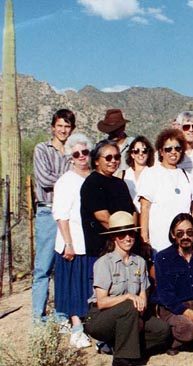Descendants of plantation owners, sharecroppers, and slaves at Louisiana's Cane River Creole National Historical Park…anglers casting into the surf at Cape Cod National Seashore…neighborhood gardeners plying the soil at Washington DC's Fort Dupont Park. NPS ethnographers—under federal and NPS legal and policy mandates—focus on these and other groups linked to the parks by religion, legend, deep historical attachment, subsistence use, or other aspects of their culture.
A park can be integral to the identity of a people, whose relationship to the land may be centuries old. Yet, in some cases, the park's reason for being may diverge from a culture's way of life. Naturalist John Muir, one of the founders of Alaska's Glacier Bay National Park, saw the place as untrammeled wilderness; to the native Tlingit or Haida, however, the bay is home, a source of food and security, where their people began. Using research approaches and other methods, ethnographers identify these constituents, giving them a voice in how parks are planned and run.
Ethnographers also assist parks in developing brochures, exhibits, and the like to tell the stakeholders' stories to the visiting public. John Pitzecker, superintendent of New Bedford Whaling National Historical Park in Massachusetts, commissioned an ethnographic study of surviving whalers in the neighborhood. Another study describes the Timbisha Shoshone who have long lived in Death Valley National Monument.
By shining local spotlights, NPS ethnographers enrich our diverse heritage as a nation.



